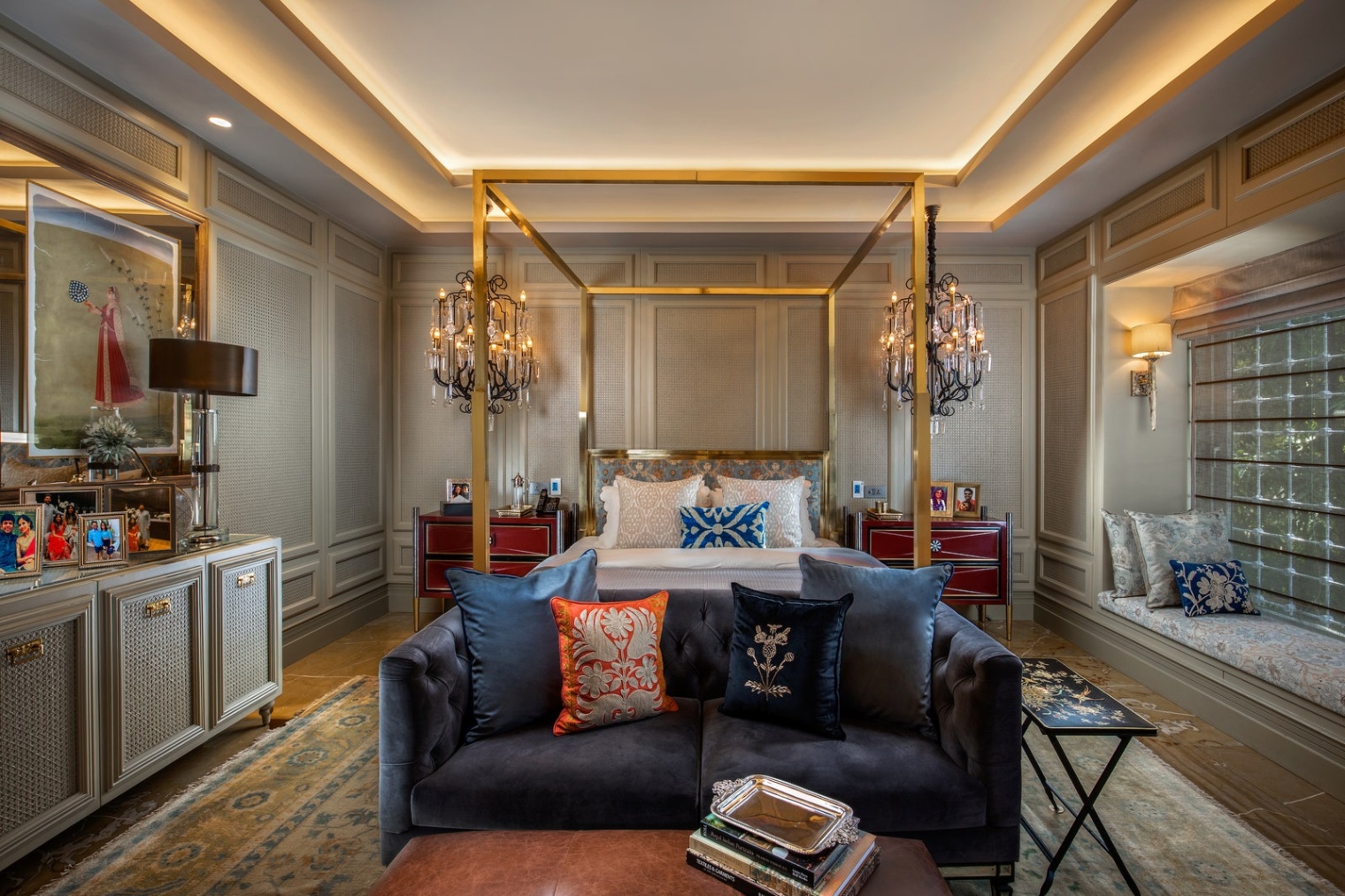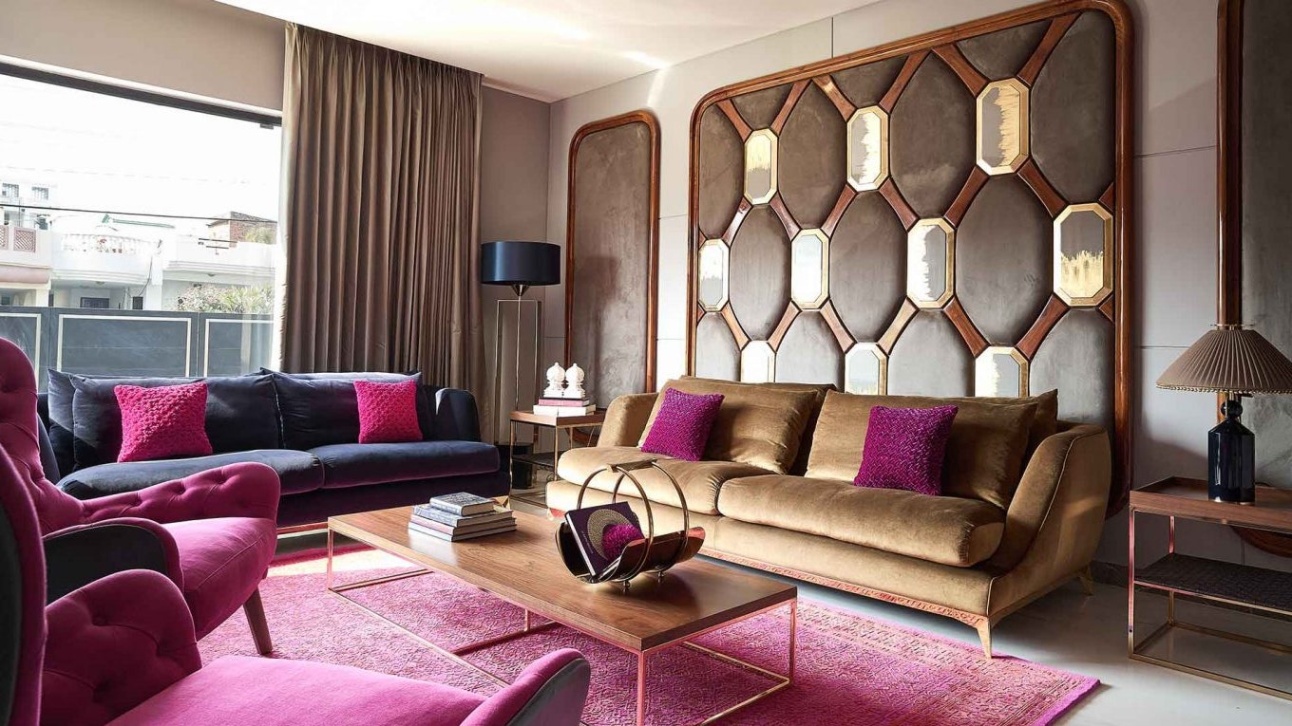1. Celebrating the Beauty of Indian Design
When it comes to Interior Design, Indian aesthetics have always been known for their vibrant colors, intricate patterns, and rich cultural heritage. From the ornate wood carvings to the elaborate tapestries, Indian design elements have a unique charm that can truly transform a space into a work of art.

Image Source: architecturaldigest.in
One of the key aspects of Indian design is the celebration of nature. Traditional Indian Homes often feature elements such as lush greenery, floral motifs, and intricate animal figures. These elements not only add a touch of natural beauty to the space but also bring a sense of peace and tranquility.
In Indian design, color plays a crucial role. Bold and bright hues such as reds, oranges, yellows, and greens are often used to create a lively and energetic atmosphere. These colors are not just visually appealing but also hold significant cultural meaning. For example, red symbolizes passion and prosperity, while yellow represents knowledge and enlightenment.

Image Source: architecturaldigest.in
Another defining feature of Indian design is the use of intricate patterns and textures. From the delicate embroidery on textiles to the detailed carvings on furniture, Indian design is all about attention to detail. These intricate patterns not only add visual interest to the space but also reflect the skilled craftsmanship that goes into creating them.
When it comes to furniture, Indian design often features pieces that are both functional and beautiful. Traditional Indian furniture is often made from rich woods such as teak, rosewood, or mahogany, and is intricately carved with geometric or floral patterns. These pieces not only add a touch of elegance to the space but also serve as a nod to India’s rich woodworking heritage.
In addition to furniture, textiles also play a crucial role in Indian interior design. From luxurious silk sarees to handwoven dhurries, Indian textiles are known for their vibrant colors and intricate designs. These textiles can be used to create stunning draperies, cushions, and bedspreads that add a touch of opulence to any space.
One of the most iconic elements of Indian design is the use of traditional art forms such as Madhubani paintings, Warli art, and Tanjore paintings. These art forms not only add a touch of cultural authenticity to the space but also serve as a reminder of India’s rich artistic heritage. By incorporating these art forms into your interior design, you can create a space that is truly unique and reflective of Indian culture.
Overall, Indian design is all about celebrating the beauty of traditional craftsmanship, vibrant colors, and intricate patterns. By embracing these elements in your interior design, you can create a space that is not only visually stunning but also deeply rooted in the rich cultural heritage of India. So why not take a cue from Indian design and infuse your home with a touch of Indian charm?
Infusing Culture into Modern Interiors
Indian Interior Design is a beautiful fusion of tradition and modernity, seamlessly blending centuries-old cultural elements with contemporary aesthetics. It is a celebration of the rich history and heritage of India, reflected in every corner of a well-designed space. From vibrant colors and intricate patterns to luxurious textiles and handcrafted decor, Indian design brings a touch of elegance and warmth to any Home.
One of the key aspects of Indian interior design is the infusion of cultural elements into modern interiors. This can be seen in the use of traditional art forms such as Madhubani paintings, Warli art, and intricate mirror work. These art forms add a unique and personal touch to the space, telling a story of India’s rich cultural heritage.
Another way Indian design infuses culture into modern interiors is through the use of traditional textiles. Fabrics such as silk, cotton, and jute are commonly used in Indian homes, adding a sense of luxury and sophistication to the space. Intricate embroidery, block prints, and handloom weaves are also popular choices, adding texture and visual interest to the decor.
Color plays a significant role in Indian interior design, with rich and vibrant hues dominating the palette. Bold shades of red, orange, pink, and turquoise are often used to create a sense of drama and energy in the space. These colors are complemented by earthy tones such as browns, greens, and yellows, creating a harmonious balance between warmth and vibrancy.
In addition to color, Indian design also incorporates patterns and motifs inspired by nature, mythology, and religious symbols. From intricate mandalas and paisley prints to floral motifs and geometric patterns, these elements add depth and character to the decor. Hand-painted tiles, wooden carvings, and brass accents are also commonly used to add a touch of opulence to the space.
Furniture plays a crucial role in Indian interior design, with a focus on comfort, functionality, and aesthetics. Traditional pieces such as carved wooden chairs, ornate coffee tables, and intricately designed cabinets are often mixed with modern furniture to create a unique and eclectic look. Soft furnishings such as silk cushions, embroidered throws, and handwoven rugs add warmth and texture to the space.
Lighting is another important element in Indian design, with an emphasis on creating a warm and inviting atmosphere. Decorative lanterns, brass lamps, and intricate chandeliers are commonly used to add a touch of glamour to the space. Natural light is also maximized through the use of sheer curtains, large windows, and strategically placed mirrors, creating a bright and airy feel.
Overall, Indian interior design is a beautiful blend of tradition and modernity, infusing culture into every aspect of the home. By incorporating elements such as traditional art, textiles, colors, patterns, and furniture, you can create a space that is not only visually stunning but also deeply rooted in India’s rich heritage. Embracing tradition in your Home Decor is a wonderful way to celebrate the beauty and elegance of Indian design.
Timeless Elegance and Rich History
Indian Interior Design is known for its timeless elegance and rich history, making it a popular choice for Homeowners who want to infuse their space with culture and tradition. From intricate patterns to vibrant colors, Indian design elements can transform any room into a stunning and inviting space.
One of the key elements of Indian interior design is the use of traditional patterns and motifs. These intricate designs are often inspired by nature, mythology, and religious symbols, and can be found in everything from textiles to furniture. Whether it’s a beautiful paisley print on a throw pillow or a hand-carved wooden screen featuring intricate floral patterns, these design elements add a touch of elegance and sophistication to any room.
In addition to patterns, Indian interior design is also known for its use of vibrant colors. From rich jewel tones like emerald green and sapphire blue to warm earthy hues like terracotta and saffron, Indian color palettes are bold and eye-catching. These colors are often used in combination with metallic accents like gold and silver to create a sense of luxury and opulence in the home.
Another defining feature of Indian interior design is the incorporation of traditional materials and craftsmanship. From intricately woven textiles like silk and cotton to hand-carved wooden furniture and brass accents, Indian design celebrates the artistry and skill of local artisans. These handmade pieces add a unique and personal touch to the home, creating a sense of warmth and authenticity that can’t be replicated with mass-produced items.
But perhaps the most striking aspect of Indian interior design is its rich history and cultural significance. Each design element has a story to tell, whether it’s a symbol of prosperity and good luck or a representation of a beloved deity. By incorporating these elements into their home décor, homeowners can connect with the rich heritage and traditions of India, creating a space that is not only beautiful but also meaningful.
In conclusion, Indian interior design is a celebration of timeless elegance and rich history. By embracing traditional patterns, vibrant colors, and handmade craftsmanship, homeowners can create a space that is both luxurious and authentic. Whether you’re drawn to the intricate designs of Indian textiles or the vibrant colors of Indian color palettes, incorporating these elements into your home décor is a surefire way to create a stunning and inviting space that reflects your love for Indian culture and tradition.
Embracing Tradition in Your Home Décor
When it comes to creating a warm and inviting living space, many people are turning to Indian Interior Design for inspiration. With its rich history and vibrant culture, Indian design offers a unique blend of tradition and modernity that can transform any home into a beautiful sanctuary.
One of the key aspects of Indian interior design is the emphasis on tradition. From intricate patterns to bold colors, Indian décor is all about celebrating the country’s rich cultural heritage. By incorporating traditional elements such as hand-woven textiles, ornate furniture, and intricate wood carvings, you can create a space that is both elegant and timeless.
One of the easiest ways to embrace tradition in your home décor is through the use of vibrant colors. In Indian design, color plays a crucial role in setting the mood of a space. Rich jewel tones like emerald green, sapphire blue, and ruby red are commonly used to create a sense of opulence and luxury. By incorporating these colors into your home décor, you can instantly add a touch of Indian flair to any room.
Another way to infuse tradition into your home décor is through the use of traditional patterns and textiles. From intricate paisley prints to bold geometric designs, Indian textiles are known for their exquisite craftsmanship and attention to detail. By incorporating these fabrics into your home décor – whether through curtains, throw pillows, or upholstery – you can add a touch of Indian elegance to any room.
In addition to colors and patterns, Indian interior design also places a strong emphasis on the use of natural materials. From hand-carved wooden furniture to luxurious silk fabrics, Indian design celebrates the beauty of natural materials in all their forms. By incorporating these materials into your home décor, you can create a space that is not only visually stunning but also environmentally friendly.
When it comes to furniture, Indian design often features ornate pieces with intricate carvings and detailing. From hand-painted cabinets to intricately carved headboards, Indian furniture is a true work of art. By incorporating these pieces into your home décor, you can add a touch of Indian luxury to any room.
Lighting is another important element of Indian interior design. In Indian culture, light is seen as a symbol of purity and enlightenment, and as such, it plays a crucial role in setting the mood of a space. By incorporating soft, ambient lighting into your home décor – whether through lanterns, candles, or string lights – you can create a warm and welcoming atmosphere that is perfect for relaxing and entertaining.
In conclusion, embracing tradition in your home décor is a wonderful way to create a warm and inviting living space that celebrates the beauty of Indian design. By incorporating vibrant colors, traditional patterns, natural materials, ornate furniture, and soft lighting into your home décor, you can create a space that is both elegant and timeless. So why not take a cue from Indian design and transform your home into a beautiful sanctuary that reflects the rich cultural heritage of this vibrant country.
indian interior design